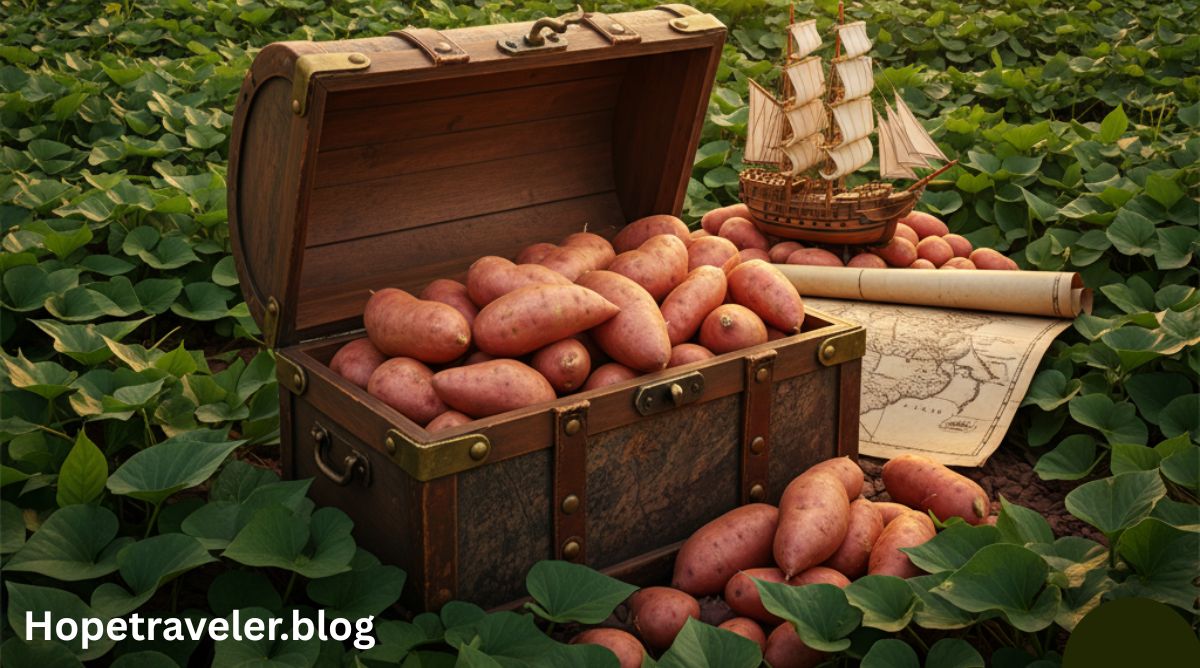Sweet potatoes are one of the most beloved root vegetables in the Southern United States, especially in Georgia, where they play an important role in both agriculture and cuisine. But have you ever wondered — how far did sweet potatoes travel to Georgia? The journey of this humble root is long, fascinating, and deeply intertwined with global history, migration, and trade.
This article explores the origins of sweet potatoes, their global voyage, how they reached Georgia, and their role in the state’s agriculture and culinary heritage.
What Are Sweet Potatoes?
Before diving into their journey, it’s important to understand what sweet potatoes actually are. Despite their name, sweet potatoes (Ipomoea batatas) are not true potatoes — they belong to the morning glory family (Convolvulaceae), while regular potatoes belong to the nightshade family (Solanaceae).
Sweet potatoes are starchy, sweet-tasting tubers that are rich in vitamin A, fiber, and antioxidants, making them both nutritious and versatile. They come in various colors — orange, white, purple, and even red.
👉 Learn more about sweet potatoes on Wikipedia’s Sweet Potato page.
Origin of Sweet Potatoes
Sweet potatoes are native to Central and South America, specifically the tropical regions that today include Peru and Ecuador. Archaeological evidence suggests that sweet potatoes were domesticated more than 5,000 years ago, making them one of the oldest cultivated crops in the Americas.
From these regions, indigenous peoples spread sweet potatoes across the continent. Eventually, through trade and exploration, they traveled across oceans and continents — long before reaching Georgia.
The Global Journey of Sweet Potatoes
To understand how far sweet potatoes traveled to Georgia, we need to trace their historical movement around the world.
1. From South America to the Caribbean
Around 2500 BCE, the sweet potato spread northward through Central America and into the Caribbean islands via indigenous trade networks. By the time European explorers arrived in the 15th century, sweet potatoes were already a well-established crop among Native peoples in the region.
2. The Arrival in Europe
After Christopher Columbus’s voyages in the late 1400s, sweet potatoes were introduced to Europe. Spanish and Portuguese explorers brought the crop back from the New World to Spain and Portugal, where it quickly gained popularity.
3. Traveling Across the Pacific
Interestingly, sweet potatoes also reached Polynesia and Asia long before European contact. Research suggests that ancient Polynesians may have sailed to South America around 1000 CE, carrying sweet potatoes back to the Pacific Islands — a journey spanning thousands of miles across the Pacific Ocean.
4. To Africa and Asia
By the 16th century, sweet potatoes had reached Africa, India, China, and Japan through Spanish and Portuguese maritime trade. They adapted well to tropical climates and became a vital food source in many parts of the world.
By the 1600s, sweet potatoes were a truly global crop, cultivated on nearly every continent.
How Sweet Potatoes Reached Georgia
The journey of sweet potatoes to Georgia is part of the broader history of crop migration to North America.
1. Early Arrival in the Southeastern United States
Sweet potatoes likely reached the southeastern region of what is now the United States during the 16th and 17th centuries, brought by Spanish explorers and settlers who arrived from the Caribbean and Mexico.
By the time English colonists began settling the southeastern seaboard, sweet potatoes were already known to the Native American tribes, who grew them as part of their agricultural system. These tribes introduced sweet potatoes to European settlers, who quickly adopted them for their adaptability and taste.
2. Perfect Climate in Georgia
Georgia’s warm climate, fertile soil, and long growing season made it an ideal place for cultivating sweet potatoes. Over time, they became a staple crop in Georgia’s agricultural landscape — alongside cotton, corn, and peanuts.
From the coastal plains to the southern farmlands, farmers across Georgia began growing sweet potatoes both for local consumption and trade.
The Distance Traveled: From South America to Georgia
If we look at the approximate geographical journey, sweet potatoes traveled an astonishing distance to reach Georgia:
- From Peru/Ecuador to the Caribbean: ~2,000 miles
- From the Caribbean to Florida/Georgia: ~1,000 miles
- Total approximate distance: 3,000 miles (4,800 kilometers)
So, the answer to how far did sweet potatoes travel to Georgia is about 3,000 miles, spanning continents and oceans — from the Andes Mountains of South America to the farmlands of Georgia, USA.
Sweet Potatoes in Georgia’s Agriculture
Today, Georgia remains one of the significant producers of sweet potatoes in the southeastern United States. The state’s farmers cultivate them for both local markets and export.
1. Major Growing Regions
Sweet potatoes thrive in southern and middle Georgia, where sandy soil and warm weather promote strong yields. Counties such as Tift, Irwin, and Coffee are known for sweet potato production.
2. Economic Importance
Although North Carolina leads the nation in sweet potato production, Georgia ranks among the top-producing states. Sweet potatoes contribute to local economies through farm sales, food industries, and farmer’s markets.
3. Varieties Grown in Georgia
Popular varieties grown in Georgia include:
- Beauregard: Known for its deep orange flesh and sweetness.
- Covington: Commonly used in pies and casseroles.
- Jewel: A Georgia favorite with moist texture and vibrant color.
Sweet Potatoes in Georgia Cuisine
Sweet potatoes are not just an agricultural product — they’re an essential part of Southern cuisine, especially in Georgia.
1. Traditional Dishes
Some of the most iconic Georgia dishes featuring sweet potatoes include:
- Sweet Potato Pie – A Southern classic, especially popular during Thanksgiving.
- Candied Yams – Sweetened with brown sugar, butter, and spices.
- Sweet Potato Casserole – Topped with marshmallows or pecans.
- Roasted Sweet Potatoes – Served as a side dish in many Georgia homes.
2. Nutritional and Cultural Significance
Sweet potatoes symbolize comfort, tradition, and sustainability in Southern cooking. They are rich in beta-carotene, vitamin C, and potassium, making them both healthy and flavorful.
👉 For more on their nutritional profile, check out Wikipedia’s article on Nutrition of Sweet Potatoes.
Scientific and Historical Importance
Sweet potatoes are also a subject of scientific and historical research, particularly for their role in early global trade. Their genetic traces found in Polynesia, Asia, and Africa demonstrate the complexity of ancient human migration and exchange.
Modern studies in botany, archaeology, and genetics confirm that sweet potatoes’ journey reflects the first major instance of global crop diffusion — long before the modern globalization era.
Preserving Sweet Potato Heritage in Georgia
In Georgia, local farmers and agricultural institutions continue to promote sweet potato cultivation through research, innovation, and sustainability practices.
- The University of Georgia’s College of Agricultural and Environmental Sciences conducts studies to improve yield and pest resistance.
- Local festivals, such as sweet potato fairs, celebrate the state’s agricultural pride and culinary creativity.
Sweet potatoes have not just traveled far in distance — they’ve also traveled through time, connecting ancient civilizations with modern-day Georgians.
Conclusion
So, how far did sweet potatoes travel to Georgia?
From the Andes Mountains of South America to the fields of Georgia, sweet potatoes journeyed roughly 3,000 miles, crossing oceans, continents, and centuries.
This remarkable journey reflects not just agricultural expansion but also human exploration, trade, and cultural exchange. Today, sweet potatoes are deeply rooted in Georgia’s soil and soul — a living reminder of how far a simple root can travel to become a symbol of nourishment and tradition.
Wikipedia References:




